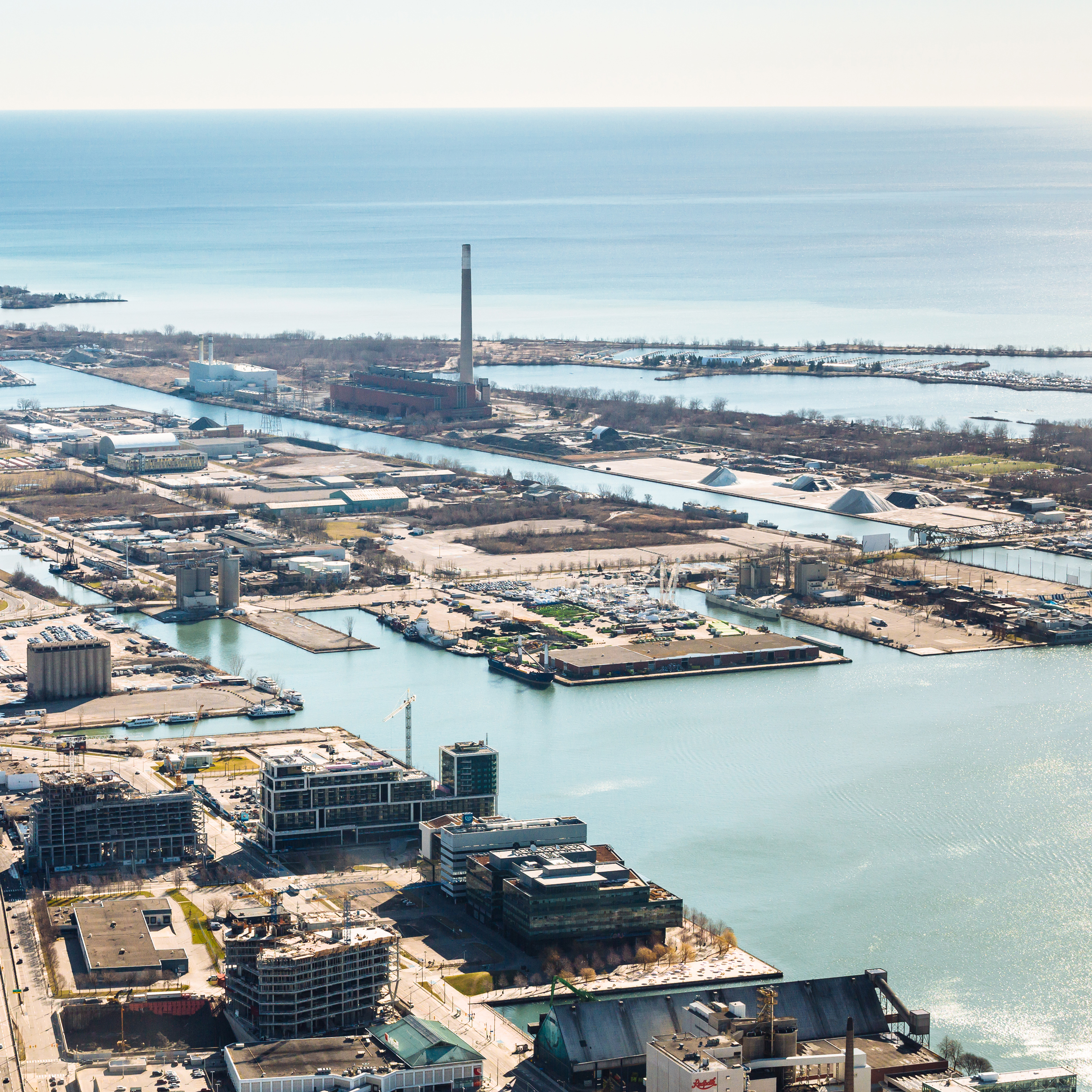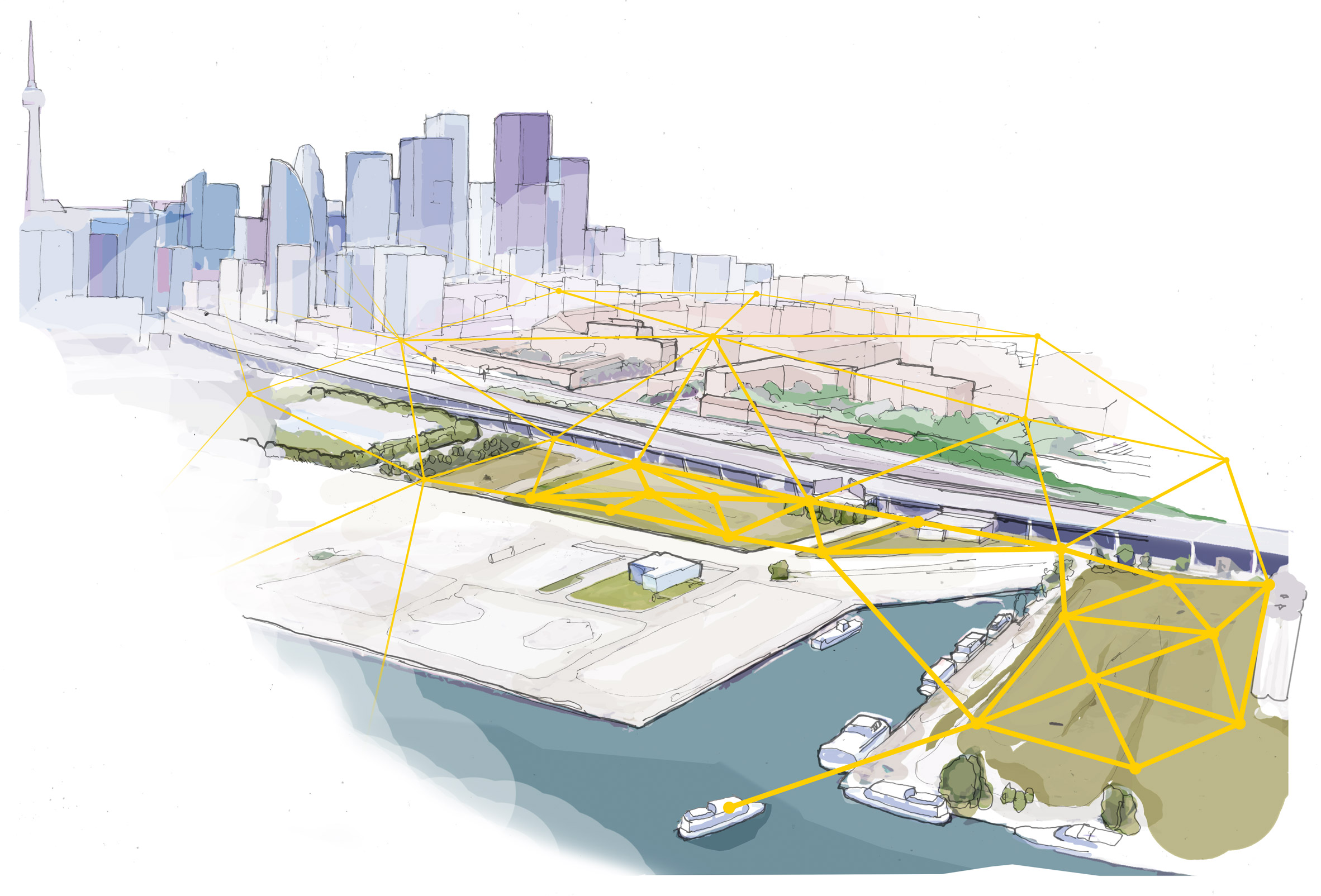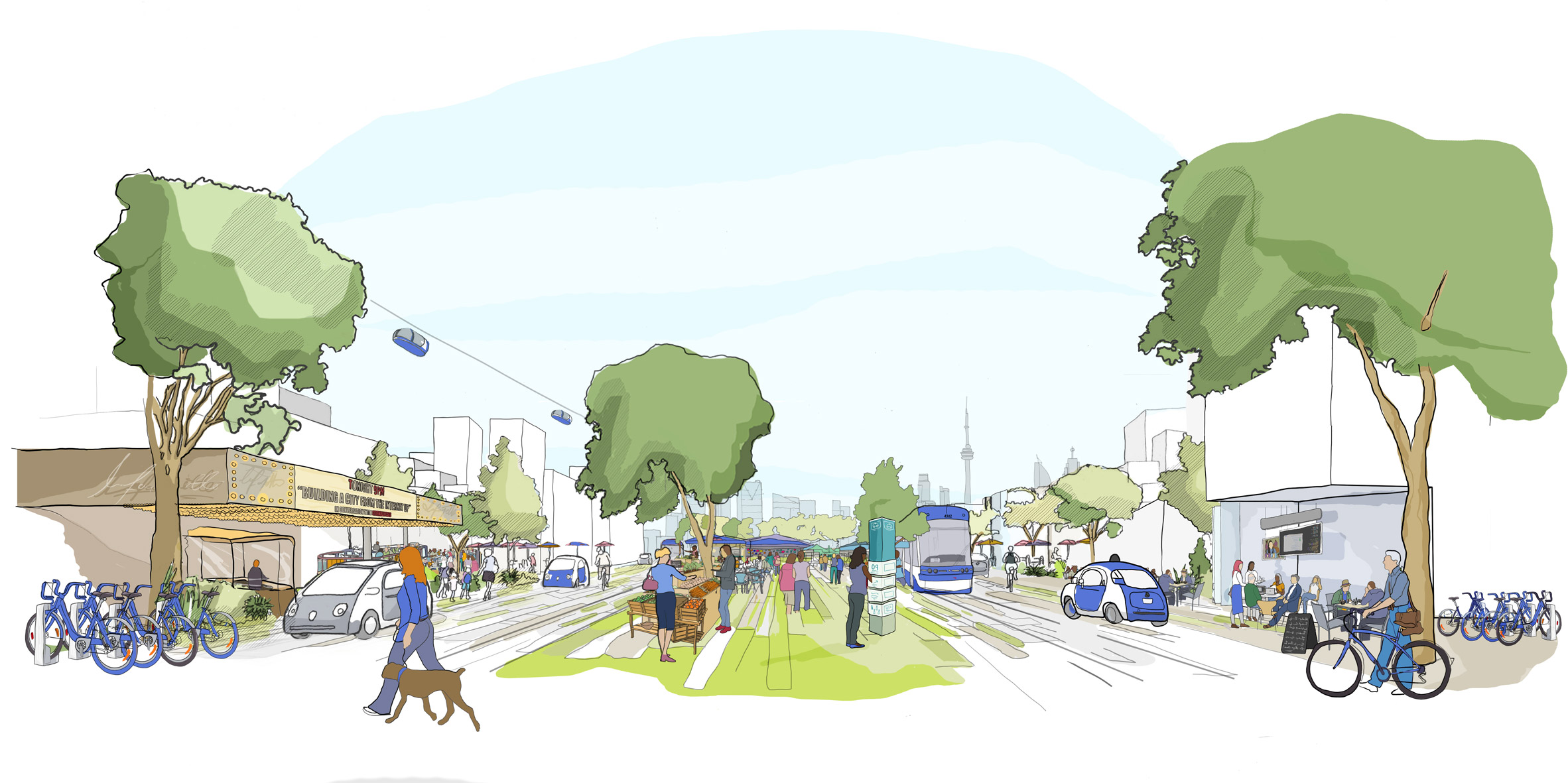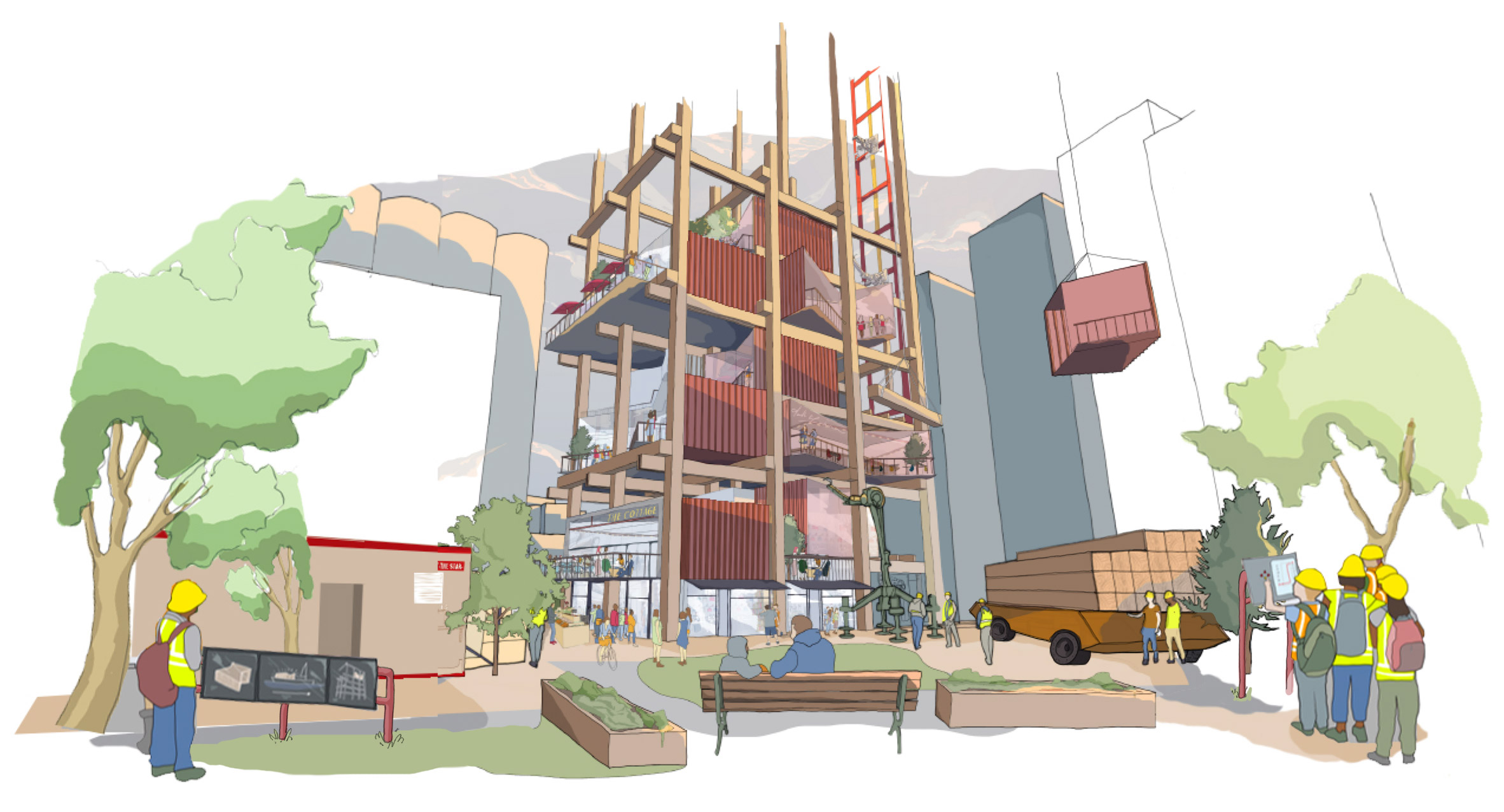After disrupting our online activities, Google‘s parent company now wants to disrupt how cities work. Dezeen spoke to Rohit Aggarwala, head of urban systems at Alphabet’s Sidewalk Labs, as it gears up to redevelop a major chunk of Toronto.
Aggarwala’s team is building an experimental new district in Canada’s largest city, where the latest technologies will be used to address urban issues like affordable housing, traffic congestion and safety, and environmental problems.
“The world needs neighbourhoods designed to take full advantage of digital technologies that are available now, and will become available in the next 10 years,” Aggarwala told Dezeen.
“It is so difficult to retrofit an existing neighbourhood,” he added. “It takes 40 or 50 years for an industrial landscape to be updated after the industry leaves. We want to speed that up.”

Sidewalk Toronto – a collaboration with Waterfront Toronto – will take over an 800-acre (324-hectare) area of unused waterfront east of Downtown and develop it from scratch.
The plans currently include implementing networks for self-driving cars, and systems for collecting and sharing data that could help improve education and healthcare services.
Sidewalk Toronto to provide a smart model for existing cities
Aggarwala is adamant that the data will only be shared to improve the neighbourhood’s design, with the proposal proving controversial in the wake of the Facebook–Cambridge Analytica data scandal, which saw data allegedly used to influence voters in political campaigns.
“We’re going to be completely transparent about the whole data collection and collect data for the purposes of making the neighbourhood work better, not because we are trying to targeted advertising, or monetise it in someway,” said Aggarwala, who led the sustainability practice at Bloomberg Associates, a consulting firm that advises city governments, prior to joining Sidewalk Labs two years ago.
He cites the main advantage of sourcing the information as enabling his team to make “fact-based, data-driven planning” decisions for the urban layout.
“If we knew the patterns of pedestrians, cyclists, vehicles, we have a much more rational basis to decide well the sidewalk ought to be this wide, and yes this route needs a bike lane or not, or the bike lane it has is too narrow, and maybe there should be few travel lanes for vehicles or more travel lanes,” he said.

Aggarwala added that ground-up neighbourhoods like this will demonstrate how to accelerate the integration of tech into cities, and offer a model for existing urban areas struggling to do the same:
“When you think about everything from Uber to bike share, and now dockless bike share, and everything about traffic systems, there are ways to apply technological advancement to those systems that technologists are much faster to identify than people like me,” he said.
“The other thing is there is a wonderful kind of impatience that is constantly asking the question, ‘well why can’t we change that faster, why can’t we try that out this quarter rather than over the next five years?’.”
Concerns about safety of driverless cars and privatisation
But as Sidewalk Labs hurries to build a city based on smart technology, the proposal forms a point of contention for many.
In an interview with Dezeen last year, architect and television presenter Jason Pomeroy told Dezeen that existing cities like Barcelona and Amsterdam are doing a better job than new purpose-built “smart cities”, which could soon become outdated, while transport designer Paul Priestman and urbanist Maarten Hajer are among those warning that autonomous cars could cause as many problems that they solve.

Sidewalk Labs’ involvement also raises concerns about allowing tech giants to create privatised cities. Aggarwala rejected this suggestion, saying the claim was a “misconception”.
“Private companies have always been involved in the process of city building, whether it’s real estate developers who have built frankly the vast majority of our city building, certainly western, or private companies that built the subway system for example, or built the railroads, or frankly provided the automobiles and the buses that we use,” he said.
Read on for an edited transcript of Dezeen’s interview with Rohit Aggarwala:
Eleanor Gibson: Can you tell me about Sidewalk Labs?
Rohit Aggarwala: Before Google transitioned to its current Alphabet structure, they identified cities as a topic that was critically important to the world – a lot of change, a lot of potential for the impact of disruption. But they wisely realised that just to have a bunch of technologists try to think about how to make cities better would probably lead to the failure.
Dan Doctoroff [a former government official and American businessman], who has straddled both the worlds, set out to create a team that was a hybrid with the world of technology. We have a bunch of people who have been at Google for a long time with technology backgrounds, people who have developed software products, a couple of people who have launched their own successful companies, as well as a bunch like me who come from more traditional urbanist moulds.
We have a culture, an ethos that is deeply informed by how cities work but has the outlook of a technology company. We started two and a half years ago. We thought about how we might realise the objective of bringing technology to improve urban lives and hit on this idea that the world needs neighbourhoods designed to take full advantage of digital technologies that are available now, and will become available in the next 10 years, because it is so difficult to retrofit an existing neighbourhood.
Eleanor Gibson: You’re coming from an urban design background. From your experience, what qualifies technologists to be responsible for designing our cities?
Rohit Aggarwala: One is they see how digital technology can be applied to more and more issues, more and more problems, and more and more opportunities.
When you think about everything from Uber to bike share, and now dockless bike share, and everything about traffic systems, there are ways to apply technological advancement to those systems that technologists are much faster to identify than people like me.
Sidewalk Labs has the outlook of a technology company
The other thing is there is a wonderful kind of impatience that is constantly asking the question: “well why can’t we change that faster, why can’t we try that out this quarter rather than over the next five years?”. That’s really important because in the world of urban policy, planning and architecture, we think in these multi-year and multi-decade type tracks.
It has to be tempered often by the reminder that the city is really not a set of systems that just need to be optimised, it’s a set of people, it’s a set of habits, it’s a set of understandings, it’s a set of social constructs, which the technologist’s background often undervalues.
Eleanor Gibson: Could you tell me about the systems that you’re planning to include in Sidewalk Toronto?
Rohit Aggarwala: Everything we’re going to do is still to be determined. There are a couple of big ideas. One is around thinking about a highly flexible built environment that can be changed very quickly to accommodate new uses. It should lower the overall cost because if you can drive up utilisation, you can lower the cost of each given use.
The second thing is that it should allow the city to constantly keep relevant. You won’t have these ebbs and flows where a neighbourhood is hot and then it ceases to be useful because its buildings are the wrong way.
The neighbourhood in Toronto should grow far more quickly than the average development
It takes 40 or 50 years for an industrial landscape to be updated after the industry leaves. It takes 10 years for commercial buildings to be converted into residential when those commercial uses are no longer relevant for a neighbourhood. We want to speed that up.
The final thing is that it will allow many more of those changes of use so that the neighbourhood in Toronto should grow far more quickly than the average development. Whether it’s modular construction or this concept that we’ve got called Loft, where you make buildings that are highly re-configurable in their interiors.

Another big one is around the public realm, and one of our fundamental ideas is that the more time people spend in shared spaces, the richer and the more robust the urban experience is going to be. We’re thinking about using technology to get people out of their private space and onto the street, or other shared spaces, much more often.
We’re trying to think about how can you moderate the extremes of weather, for example, to make the outdoors comfortable during a wide-range of weather conditions. The overall objective is to have a public realm that acts as the city’s living room.
A bunch of other things that we’re thinking about include digital approaches to making the social and the human services much more responsive, and sustainability.
Eleanor Gibson: How do you think it is going to impact the cities of the future?
Rohit Aggarwala: Mobility is an issue for all cities. We are big believers of the promise of self-driving technology and we have proposed that at least a large portion of this area be reserved for self-driving vehicles.
The public realm will act as the city’s living room
That’s where we will be able to show the world what the urban environment can look and feel like, and how useful it can be when you move it out of the world of human-powered vehicles with all of their flaws and errors, and into a world of on-demand shared-drive as our primary mode of getting around within the district.
Eleanor Gibson: There are many problems associated with driverless cars, have you thought about these in your plans?
Rohit Aggarwala: Self-driving technology is obviously evolving, so there are lots of questions that will shape when it is ready for a mixed environment with other traffic, and when can you use it in an environment at probably slower speeds and without traditional vehicles.
Security is something that we are thinking about across the board. The questions about whether these vehicles are fit to be on the street is going to be something that the governments and regulators are going to have to weigh in on, just as much as those who are developing technologies.
Sidewalk Labs is not actually developing any self-driving technology. What we are excited about doing though is creating a place that is ready to reap the benefits of self-driving technology for cities.
It isn’t just about having a taxi that doesn’t have a driver in it, it’s actually also about having streets that are much more pleasant, where travel lanes might be narrower, where you don’t have any on street parking cluttering your neighbourhood. Those are really big things that can and should shape the way that people approach that technology.
Eleanor Gibson: Have you thought about other tech forces that might come into play, like Augmented Reality (AR), Virtual Reality (VR) and drones?
Rohit Aggarwala: We have one concept for a robot-based last-mile delivery system that is intended to both reduce the number of delivery vans that are a factor in creating traffic and diminishing the public realm in certain areas, but also to make it better to get deliveries. That’s an opportunity to, for example, help local retail compete with companies that do very fast deliveries.
If you have an easy delivery service that can operate on demand at a low cost, you actually have the potential for the same kind of “well I can deliver my product to you in an hour next day” – the same way Amazon can, at the same cost that they get.
We are big believers of the promise of self-driving technology
We’re certainly excited about the potential for drones. There’s no question in my mind that they have a massive role to play in low-density areas, but in a dense urban environment, they may or may not be as important. There are likely to be long-term restraints on what we can do with drones, but we’ll certainly be trying to coordinate everything we do to make use of drones when they are ready and to the extent that they are allowed.
Augmented reality and virtual reality are certainly things that we are looking into. There are a number of ideas around how you use AR and VR in the actual planning and design process for example. A lot of technologies related to AR and VR can reduce the cost and time of construction as it can be planned better.

Over the long term, after a place is built, those technologies have a huge potential to improve neighbourhoods. Right now if something goes wrong with the electric system or the sewer, the first thing that you have to do is send somebody down into the manhole and see what’s going on. We can imagine that with computer simulation we might be able to run a model saying ‘we know that this is going on, and where we think the break in the pipe might be’ and make a prediction before sending somebody in. That will reduce maintenance costs and improve performance.
Eleanor Gibson: How will all of the infrastructure in the project be funded?
Rohit Aggarwala: That’s among the many questions that are we going to continue to work on over the course of this year.
I’m sure there are going to be some aspects of the infrastructure where there is a very traditional approach, whether it’s the government or the utilities or what have you. There is probably going to be some sort of more innovative structure.
Of course the idea of a public-private partnership, some people think it’s great, while some are worried it’s a bad deal for government.
There is a wide variety of approaches when you use a hybrid structure to make a big adjustment and no doubt if we use a useful mechanism, we will propose what the constraints and conditions and terms laid out might need to be Hopefully that will get evaluated on merit as opposed to just being in a position that privatisation is always bad, or privatisation is always deemed the answer.
Augmented Reality and Virtual Reality can reduce the cost and time of construction
There is always the chance to use this neighbourhood to explore some of the new approaches that affects many Ontario-based entities that we are always thinking about: is there a new way to think about district heating and cooling, both in terms of technology and the infrastructure?; is this an opportunity to look at what a real micro-grid might look like?
And what an appropriate neighbourhood-based business model for that might be, because one of the nice things about a micro-grid is that it doesn’t necessarily have to be done through an existing utility but it could be done in partnership with one, for example.
Eleanor Gibson: Do you think the cities of the future will become increasingly privatised?
Rohit Aggarwala: I don’t and I think it’s a misconception to look at what we are proposing in Toronto as being a privatisation. Private companies have always been involved in the process of city building, whether it’s real-estate developers who have built frankly the vast majority of our city building, certainly in the west, or private companies that built the subway system for example, or built the railroads, or frankly provided the automobiles and the buses that we use.
Eleanor Gibson: Who will own the data that is collected in the Sidewalk Toronto and how will it be shared?
Rohit Aggarwala: The actual ownership of different kinds of data is something we are still working on.
The fundamental principles about data shared in our town hall meeting a while ago now were that: number one, we’re going to be completely transparent about the whole data collection; number two, collect data for the purposes of making the neighbourhood work better, not because we are trying to targeted advertising, or monetise it in someway.
No doubt in a technologically advanced neighbourhood there is going to be data collected by lots of different groups, of lots of different kinds. And again, depending on the arrangement that we have with the city and with Waterfront Toronto, that will have to get worked out – who is in charge of data and who has ownership.
We’re going to be completely transparent about the whole data collection
We want to embrace this idea of privacy by design. We want to develop systems that will not capture personally identifiable information unless it is intentionally for the purposes of something where we are identifying an individual so that would be on a consensual basis.
One of the things that I want to caution is that there is this idea that the data is being collected, and that all of the data is being collected by Sidewalk Labs or Sidewalk Toronto, and I don’t think we know if that is the case yet.
Eleanor Gibson: Can you give some examples of how the data could be used?
Rohit Aggarwala: We’ve talked about how we would like to have much better data on what is going on in public spaces, public spaces broadly defined from everything from vehicles on the road to people walking down the street, to people using public areas for recreation.
One of the big frustrations that many urban planners have, and I would say when I was in city government, is that generally speaking, city officials have a much better understanding of how many cars are going down the street than how many people are walking down a sidewalk.
That makes it very difficult to justify in any number of cases in Toronto where different road approaches have been advocated for, in terms of bike lanes and pedestrian space. One of the reasons these end up being a political battle, as opposed to a fact-based data driven planning approach, is that we generally don’t have really good data on all users.
Until the world sees the digital urban future, it will be difficult to have existing cities get there
If we knew what are the patterns of how many pedestrians walk down the sidewalk, how many cyclists use the bike lane, how many vehicles go down the street, and how many are private vehicles, how many are delivery vans, how many are street cars, we have a much more rational basis to decide well the sidewalk ought to be this wide, and yes this route needs a bike lane or not, or the bike lane it has is too narrow, and maybe there should be few travel lanes for vehicles or more travel lanes.
Eleanor Gibson: A number of new smart cities have recently been announced. Is the start of a new era in urban design?
Rohit Aggarwala: The impatience in the technology sector to see change happen quickly is leading to thinking about new projects as opposed to simply working with an existing city government to retrofit. It is equally true that the big-scale impacts of those innovations will grow as you suggest, when they are spread to those existing cities.
But frankly until the world sees the digital urban future, it’s going to be much more difficult to have existing cities get there.
Eleanor Gibson: What is your response to the criticism of these new developments?
Rohit Aggarwala: New cities have tended to be problematic, but not forever. When Sidewalk Labs started, we looked at these examples of model cities and new cities, and what you find over and over again for example is that they make two big mistakes.
One is that they assume that whatever technology they have, that’s the end of history and it’s not going to evolve, and so we don’t think that’s the right way to think. We’re not going to make that mistake.
The world will wind up adopting the right lessons from this place if we pull it off
We’re going to build certain things in but we’re also going to make sure that if our assumptions – whether it’s self-driving cars or maybe drones – are even more important than what I was just saying they are, those things change. But this neighbourhood will still be adjustable to whatever the technology is. The other thing is that they don’t recognise the extent to which what makes a city authentic is the accumulative human experience there.
Part of what we would want to design is the ability of a place to be customised by the people who live there and work there and visit it. The more you can do that, you actually can create that sense of authenticity or sort of things that we think we can do with technology.
Eleanor Gibson: Have you thought about how the principles you’re investigating could be transferred to established cities?
Rohit Aggarwala: Cities learn from each other quite rapidly, and what you need is both the demonstrated value of something and then you need a clearly understandable recipe for how it might work, like what Paris’ Velib did with bike sharing, or what New York did with the High Line: innovations that are easily transferable from city to city. I am not at all worried that the world will wind up adopting the right lessons from this place if we pull it off.
Eleanor Gibson: Will existing cities be able to catch up?
Rohit Aggarwala: They definitely will. Our belief is not that technology isn’t relevant for existing cities, our belief was that to show the real impact of what these technologies do would be to implement them all together. We’re not going to be able to do that for a long time with an existing city, primarily because you have a lot of constraints: you have existing residents, you have existing parentheses, you have existing infrastructure.
To think that you could change all of those things, and do so in a democratic way, it just requires too much change all at once and that’s why what you see is existing cities, they don’t change in a revolutionary way most of the time. They usually change in an evolutionary way.
When you have the chance to build something new, you can be much faster and much more comprehensive in the changes that you make. You have the opportunity to invite people in, rather than having it imposed on the neighbourhoods that they’ve been living or working in for some time. It’s not at all a statement that all cities are obsolete, it’s a strategy for how our company can have impact on the world.
Eleanor Gibson: What are some of the problems that you think cities will face in the future?
Rohit Aggarwala: We are conscious of the fact that neither digital technology or Sidewalk Labs will solve everything as that would be an unrealistic objective. What we can do is set challenges that we know are common to these cities. In virtually all cities the cost of constructing multi-family apartment buildings is a barrier to market entry. The cost of renovating places is actually a barrier to new businesses being formed, to families having the kind of housing that they want, to neighbourhoods changing quickly. So if we can tackle those problems, we are providing value to the world.
The post “It takes 40 or 50 years to update an industrial landscape. We want to speed that up,” says Sidewalk Labs urban planner appeared first on Dezeen.
